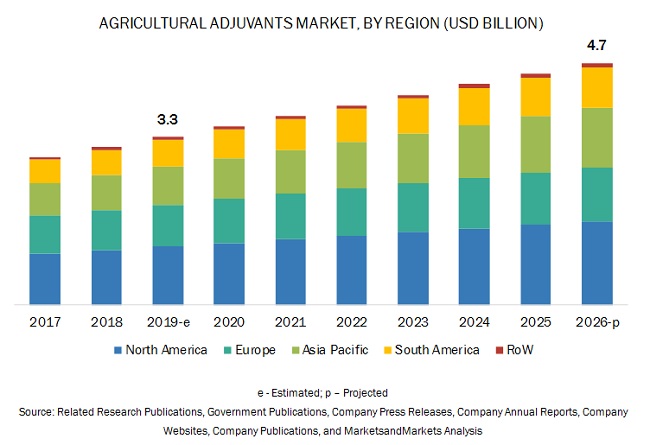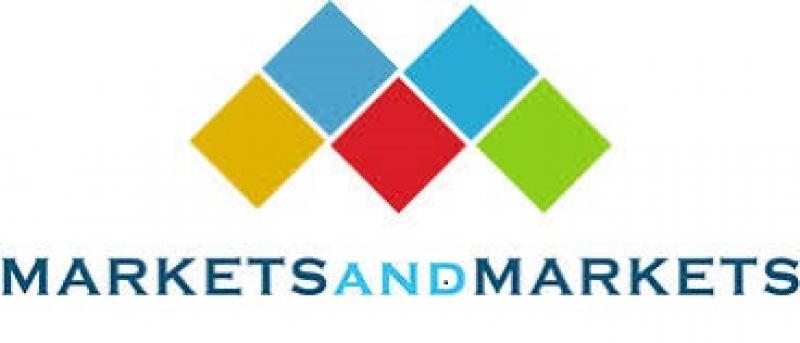Increase in Need for Green Adjuvants Drives the Agricultural Adjuvants Market
The agricultural adjuvants market is estimated to account for a value of USD 3.3 billion in 2019 and is projected to grow at a CAGR of 5.3% from 2019, to reach a value of USD 4.7 billion by 2026. An increasing need for green adjuvants, improving efficiency and effectiveness of agrochemicals are some of the factors driving the growth of this market.

Report Objectives:
- To define, segment, and project the global market size of the agricultural adjuvants market.
- To understand the agricultural adjuvants market by identifying its various subsegments
- To provide detailed information about the key factors influencing the growth of the market (drivers, restraints, opportunities, and industry-specific challenges)
- To analyze the micromarkets with respect to individual growth trends, future prospects, and their contribution to the total market
- To project the size of the market and its submarkets, in terms of value, with respect to the regions (along with their respective key countries)
- To profile key players and comprehensively analyze their core competencies
- To understand the competitive landscape and identify major growth strategies adopted by players across key regions
- To analyze the competitive developments such as expansions & investments, mergers & acquisitions, new product launches, partnerships, joint ventures, collaborations, divestments, disinvestments, and agreements
Download PDF Brochure: https://www.marketsandmarkets.com/pdfdownloadNew.asp?id=1240
Increasing need for green adjuvants
Most adjuvants that are added in crop protection chemicals are derived from petroleum or other chemical sources. The surplus use of these chemically derived adjuvants in pesticide affects the environment and human health. For example, nonylphenol ethoxylate, a wetting and dispersing agent, is still used in some agrochemical applications. This surfactant causes endocrine toxicity in animals and is also toxic to aquatic organisms. Hence, government authorities and adjuvant manufacturers have been shifting their focus on renewable and sustainable products. This trend will lead to high demand for naturally derived products that pose a negligible threat to the environment as compared to conventional petroleum-derived products that are toxic in nature and can lead to bioaccumulation within the ecosystem.
In recent years, the demand for bio-based adjuvants such as methylated seed oil (MSO), modified vegetable oils, and organo-modified siloxanes has been growing. These biologically derived adjuvants are considered eco-friendly due to their high level of safety and biodegradability. The rising awareness among consumers for the use of renewable and natural ingredients boosts the demand for bio-based adjuvants and the development of greener solutions for various applications such as agriculture, cosmetics, and pharmaceuticals. The manufacturers are, therefore, keen to adapt to this changing trend of utilizing green adjuvants in their products. Also, there are few players such as Wilbur-Ellis Holdings, Inc. (US) and Precision Laboratories, LLC (US) that offer products containing methylated seed oil.
The cereals & grains segment, by crop type, is estimated to account for the largest market share, by value, in 2019
Cereals & grains accounted for the largest consumption of herbicides in North America and Asia Pacific, owing to the high cultivation of corn and wheat in countries such as the US and China. Adjuvants are added to the commercial formulae of herbicides to improve their efficacy by increasing the adhesion properties of herbicides to the leaf surface, as well as aiding transport across the waxy cuticle membrane and into the plant. Adjuvants used in herbicide treatment solutions for cereals & grains aim to improve spray droplet retention and penetration of active ingredients into the plant foliage. Thus, cereals and grains are estimated to be the most popular crop type in the agricultural adjuvants market.
Request for Customization: https://www.marketsandmarkets.com/requestCustomizationNew.asp?id=1240
Asia Pacific is projected to grow at the highest CAGR during the forecast period
The market for agricultural adjuvants in the Asia Pacific region is expected to grow at the highest CAGR from 2019 to 2026, owing to the increasing investments by key players in countries such as China, India, and Thailand, and also the rising adoption of adjuvant technology by the crop growers for insecticide applications. Due to these factors, the market in the Asia Pacific region is projected to record the highest growth from 2019 to 2026.
This report includes a study on the marketing and development strategies, along with a study on the product portfolios of the leading companies operating in the agricultural adjuvants market. It includes the profiles of leading companies such as Miller Chemical and Fertilizer, LLC (US), Precision Laboratories (US), CHS Inc (US), Winfield United (US), Kalo Inc. (US), Nouryon (Netherlands), Corteva Inc. (US), Evonik Industries (Germany), Nufarm (Australia), Croda International (UK), Solvay (Belgium), BASF (Germany), Huntsman Corporation (US), Clariant (US), Helena Agri-Enterprises (US), Stepan Company (US), Wilbur-Ellis Company (US), Brandt (US), Plant Health Technologies (US), and Innvictis Crop Care (US).
